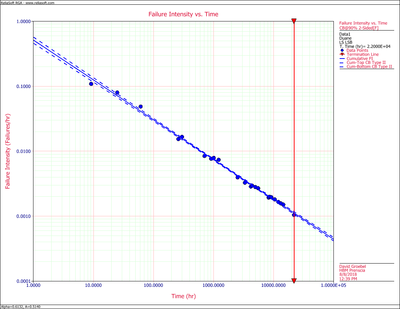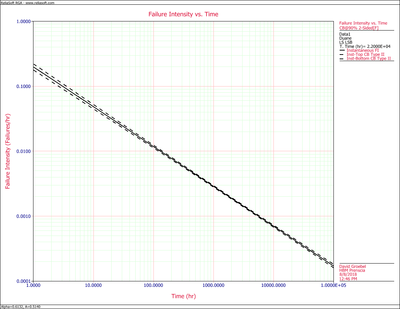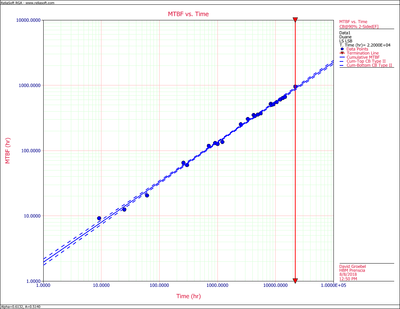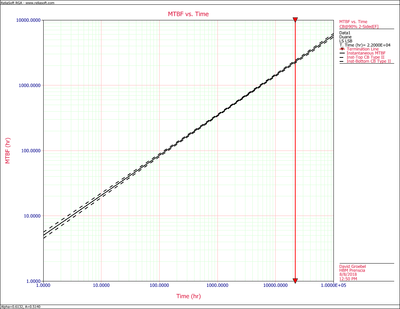Duane Confidence Bounds Example: Difference between revisions
Kate Racaza (talk | contribs) No edit summary |
mNo edit summary |
||
| Line 6: | Line 6: | ||
Using the values of <math>\widehat{b}\,\!</math> and <math>\widehat{\alpha }\,\!</math> estimated from the least squares analysis in <noinclude>[[Duane Linear Regression Examples| | Using the values of <math>\widehat{b}\,\!</math> and <math>\widehat{\alpha }\,\!</math> estimated from the least squares analysis in <noinclude>[[Duane Linear Regression Examples| | ||
Least Squares Example 2]]</noinclude><includeonly>Least Squares Example 2</includeonly>: | Least Squares Example 2]]</noinclude><includeonly>Least Squares Example 2</includeonly>: | ||
:<math>\widehat{b}=1.9453\,\!</math> | |||
:<math>\widehat{\alpha}=0.6133\,\!</math> | |||
calculate the 90% confidence bounds for: | calculate the 90% confidence bounds for: | ||
| Line 15: | Line 14: | ||
#The cumulative and instantaneous failure intensity. | #The cumulative and instantaneous failure intensity. | ||
#The cumulative and instantaneous MTBF. | #The cumulative and instantaneous MTBF. | ||
'''Solution''' | '''Solution''' | ||
1. | 1. Use the values of <math>\widehat{b}\,\!</math> and <math>\widehat{\alpha }\,\!</math> estimated from the least squares analysis. Then: | ||
:<math>\begin{align} | |||
{{S}_{xx}}&=\left[ \underset{i=1}{\overset{n}{\mathop \sum }}\,{{(\ln {{t}_{i}})}^{2}} \right]-\frac{1}{n}{{\left( \underset{i=1}{\overset{n}{\mathop \sum }}\,\ln ({{t}_{i}}) \right)}^{2}} \\ | {{S}_{xx}}&=\left[ \underset{i=1}{\overset{n}{\mathop \sum }}\,{{(\ln {{t}_{i}})}^{2}} \right]-\frac{1}{n}{{\left( \underset{i=1}{\overset{n}{\mathop \sum }}\,\ln ({{t}_{i}}) \right)}^{2}} \\ | ||
& = 1400.9084-1301.4545 \\ | & = 1400.9084-1301.4545 \\ | ||
| Line 27: | Line 25: | ||
\end{align}\,\!</math> | \end{align}\,\!</math> | ||
:<math>\begin{align} | |||
SE(\hat{\alpha })= & \frac{\sigma }{\sqrt{{{S}_{xx}}}} \\ | SE(\hat{\alpha })= & \frac{\sigma }{\sqrt{{{S}_{xx}}}} \\ | ||
= & \frac{0.08428}{9.9727} \\ | = & \frac{0.08428}{9.9727} \\ | ||
| Line 34: | Line 31: | ||
\end{align}\,\!</math> | \end{align}\,\!</math> | ||
:<math>\begin{align} | |||
SE(\ln \hat{b})= & \sigma \cdot \sqrt{\frac{\underset{i=1}{\overset{n}{\mathop{\sum }}}\,{{(\ln {{T}_{i}})}^{2}}}{n\cdot {{S}_{xx}}}} \\ | SE(\ln \hat{b})= & \sigma \cdot \sqrt{\frac{\underset{i=1}{\overset{n}{\mathop{\sum }}}\,{{(\ln {{T}_{i}})}^{2}}}{n\cdot {{S}_{xx}}}} \\ | ||
= & 0.065960 | = & 0.065960 | ||
\end{align}\,\!</math> | \end{align}\,\!</math> | ||
Thus, the 90% confidence bounds on parameter <math>\alpha \,\!</math> are: | Thus, the 90% confidence bounds on parameter <math>\alpha \,\!</math> are: | ||
:<math>C{{B}_{\alpha }}=\hat{\alpha }\pm {{t}_{n-2,\alpha /2}}SE(\hat{\alpha })\,\!</math> | |||
:<math>\begin{align} | |||
{{\alpha }_{L}}= & 0.602050 \\ | {{\alpha }_{L}}= & 0.602050 \\ | ||
{{\alpha }_{U}}= & 0.624417 | {{\alpha }_{U}}= & 0.624417 | ||
\end{align}\,\!</math> | \end{align}\,\!</math> | ||
And 90% confidence bounds on parameter <math>b\,\!</math> are: | And 90% confidence bounds on parameter <math>b\,\!</math> are: | ||
:<math>C{{B}_{b}}=\hat{b}{{e}^{\pm {{t}_{n-2,\alpha /2}}SE\left[ \ln (\hat{b}) \right]}}\,\!</math> | |||
:<math>\begin{align} | |||
{{b}_{L}}= & 1.7831 \\ | {{b}_{L}}= & 1.7831 \\ | ||
{{b}_{U}}= & 2.1231 | {{b}_{U}}= & 2.1231 | ||
\end{align}\,\!</math> | \end{align}\,\!</math> | ||
2. The cumulative failure intensity is: | |||
:<math>\begin{align} | |||
{{\lambda }_{c}}= & \frac{1}{1.9453}\cdot {{22000}^{-0.6133}} \\ | {{\lambda }_{c}}= & \frac{1}{1.9453}\cdot {{22000}^{-0.6133}} \\ | ||
= & 0.00111689 | = & 0.00111689 | ||
\end{align}\,\!</math> | \end{align}\,\!</math> | ||
And the instantaneous failure intensity is equal to: | And the instantaneous failure intensity is equal to: | ||
:<math>\begin{align} | |||
{{\lambda }_{i}}= & \frac{1}{1.9453}\cdot (1-0.6133)\cdot {{22000}^{-0.6133}} \\ | {{\lambda }_{i}}= & \frac{1}{1.9453}\cdot (1-0.6133)\cdot {{22000}^{-0.6133}} \\ | ||
= & 0.00043198 | = & 0.00043198 | ||
\end{align}\,\!</math> | \end{align}\,\!</math> | ||
So, at the 90% confidence level and for <math>T=22,000\,\!</math> hours, the confidence bounds on cumulative failure intensity are: | So, at the 90% confidence level and for <math>T=22,000\,\!</math> hours, the confidence bounds on cumulative failure intensity are: | ||
:<math>\begin{align} | |||
{{[{{\lambda }_{c}}(t)]}_{L}}= & 0.00100254 \\ | {{[{{\lambda }_{c}}(t)]}_{L}}= & 0.00100254 \\ | ||
{{[{{\lambda }_{c}}(t)]}_{U}}= & 0.00124429 | {{[{{\lambda }_{c}}(t)]}_{U}}= & 0.00124429 | ||
\end{align}\,\!</math> | \end{align}\,\!</math> | ||
For the instantaneous failure intensity: | For the instantaneous failure intensity: | ||
:<math>\begin{align} | |||
{{[{{\lambda }_{i}}(t)]}_{L}}= & 0.00038775 \\ | {{[{{\lambda }_{i}}(t)]}_{L}}= & 0.00038775 \\ | ||
{{[{{\lambda }_{c}}(t)]}_{U}}= & 0.00048125 | {{[{{\lambda }_{c}}(t)]}_{U}}= & 0.00048125 | ||
\end{align}\,\!</math> | \end{align}\,\!</math> | ||
The following figures show the graphs of the cumulative and instantaneous failure intensity. Both are plotted with confidence bounds. | The following figures show the graphs of the cumulative and instantaneous failure intensity. Both are plotted with confidence bounds. | ||
[[Image:rga4.7.png|center|400px|Cumulative Failure Intensity plot with 2-sided 90% confidence bounds.]] | [[Image:rga4.7.png|center|400px|Cumulative Failure Intensity plot with 2-sided 90% confidence bounds.]] | ||
[[Image:rga4.8.png|center|400px|Instantaneous Failure Intensity plot with 2-sided 90% confidence bounds.]] | [[Image:rga4.8.png|center|400px|Instantaneous Failure Intensity plot with 2-sided 90% confidence bounds.]] | ||
3. | 3. The cumulative MTBF is: | ||
:<math>\begin{align} | |||
{{m}_{c}}(T)= & 1.9453\cdot {{22000}^{0.6133}} \\ | {{m}_{c}}(T)= & 1.9453\cdot {{22000}^{0.6133}} \\ | ||
= & 895.3395 | = & 895.3395 | ||
\end{align}\,\!</math> | \end{align}\,\!</math> | ||
And the instantaneous MTBF is: | And the instantaneous MTBF is: | ||
:<math>\begin{align} | |||
{{m}_{i}}(T)= & \frac{1.9453}{1-0.6133}\cdot {{22000}^{0.6133}} \\ | {{m}_{i}}(T)= & \frac{1.9453}{1-0.6133}\cdot {{22000}^{0.6133}} \\ | ||
= & 2314.9369 | = & 2314.9369 | ||
\end{align}\,\!</math> | \end{align}\,\!</math> | ||
So, at 90% confidence level and for <math>T=22,000\,\!</math> hours, the confidence bounds on the cumulative MTBF are: | So, at 90% confidence level and for <math>T=22,000\,\!</math> hours, the confidence bounds on the cumulative MTBF are: | ||
:<math>\begin{align} | |||
{{m}_{c}}{{(t)}_{l}}= & 803.6695 \\ | {{m}_{c}}{{(t)}_{l}}= & 803.6695 \\ | ||
{{m}_{c}}{{(t)}_{u}}= & 997.4658 | {{m}_{c}}{{(t)}_{u}}= & 997.4658 | ||
\end{align}\,\!</math> | \end{align}\,\!</math> | ||
The confidence bounds for the instantaneous MTBF are: | The confidence bounds for the instantaneous MTBF are: | ||
:<math>\begin{align} | |||
{{m}_{i}}{{(t)}_{l}}= & 2077.9204 \\ | {{m}_{i}}{{(t)}_{l}}= & 2077.9204 \\ | ||
{{m}_{i}}{{(t)}_{u}}= & 2578.9886 | {{m}_{i}}{{(t)}_{u}}= & 2578.9886 | ||
\end{align}\,\!</math> | \end{align}\,\!</math> | ||
The figure below displays the cumulative MTBF. | The figure below displays the cumulative MTBF. | ||
Revision as of 22:50, 30 January 2014
New format available! This reference is now available in a new format that offers faster page load, improved display for calculations and images and more targeted search.
As of January 2024, this Reliawiki page will not continue to be updated. Please update all links and bookmarks to the latest references at RGA examples and RGA reference examples.
This example appears in the Reliability Growth and Repairable System Analysis Reference book.
Using the values of [math]\displaystyle{ \widehat{b}\,\! }[/math] and [math]\displaystyle{ \widehat{\alpha }\,\! }[/math] estimated from the least squares analysis in Least Squares Example 2:
- [math]\displaystyle{ \widehat{b}=1.9453\,\! }[/math]
- [math]\displaystyle{ \widehat{\alpha}=0.6133\,\! }[/math]
calculate the 90% confidence bounds for:
- The parameters [math]\displaystyle{ \alpha\,\! }[/math] and [math]\displaystyle{ b\,\! }[/math].
- The cumulative and instantaneous failure intensity.
- The cumulative and instantaneous MTBF.
Solution
1. Use the values of [math]\displaystyle{ \widehat{b}\,\! }[/math] and [math]\displaystyle{ \widehat{\alpha }\,\! }[/math] estimated from the least squares analysis. Then:
- [math]\displaystyle{ \begin{align} {{S}_{xx}}&=\left[ \underset{i=1}{\overset{n}{\mathop \sum }}\,{{(\ln {{t}_{i}})}^{2}} \right]-\frac{1}{n}{{\left( \underset{i=1}{\overset{n}{\mathop \sum }}\,\ln ({{t}_{i}}) \right)}^{2}} \\ & = 1400.9084-1301.4545 \\ & = 99.4539 \end{align}\,\! }[/math]
- [math]\displaystyle{ \begin{align} SE(\hat{\alpha })= & \frac{\sigma }{\sqrt{{{S}_{xx}}}} \\ = & \frac{0.08428}{9.9727} \\ = & 0.008452 \end{align}\,\! }[/math]
- [math]\displaystyle{ \begin{align} SE(\ln \hat{b})= & \sigma \cdot \sqrt{\frac{\underset{i=1}{\overset{n}{\mathop{\sum }}}\,{{(\ln {{T}_{i}})}^{2}}}{n\cdot {{S}_{xx}}}} \\ = & 0.065960 \end{align}\,\! }[/math]
Thus, the 90% confidence bounds on parameter [math]\displaystyle{ \alpha \,\! }[/math] are:
- [math]\displaystyle{ C{{B}_{\alpha }}=\hat{\alpha }\pm {{t}_{n-2,\alpha /2}}SE(\hat{\alpha })\,\! }[/math]
- [math]\displaystyle{ \begin{align} {{\alpha }_{L}}= & 0.602050 \\ {{\alpha }_{U}}= & 0.624417 \end{align}\,\! }[/math]
And 90% confidence bounds on parameter [math]\displaystyle{ b\,\! }[/math] are:
- [math]\displaystyle{ C{{B}_{b}}=\hat{b}{{e}^{\pm {{t}_{n-2,\alpha /2}}SE\left[ \ln (\hat{b}) \right]}}\,\! }[/math]
- [math]\displaystyle{ \begin{align} {{b}_{L}}= & 1.7831 \\ {{b}_{U}}= & 2.1231 \end{align}\,\! }[/math]
2. The cumulative failure intensity is:
- [math]\displaystyle{ \begin{align} {{\lambda }_{c}}= & \frac{1}{1.9453}\cdot {{22000}^{-0.6133}} \\ = & 0.00111689 \end{align}\,\! }[/math]
And the instantaneous failure intensity is equal to:
- [math]\displaystyle{ \begin{align} {{\lambda }_{i}}= & \frac{1}{1.9453}\cdot (1-0.6133)\cdot {{22000}^{-0.6133}} \\ = & 0.00043198 \end{align}\,\! }[/math]
So, at the 90% confidence level and for [math]\displaystyle{ T=22,000\,\! }[/math] hours, the confidence bounds on cumulative failure intensity are:
- [math]\displaystyle{ \begin{align} {{[{{\lambda }_{c}}(t)]}_{L}}= & 0.00100254 \\ {{[{{\lambda }_{c}}(t)]}_{U}}= & 0.00124429 \end{align}\,\! }[/math]
For the instantaneous failure intensity:
- [math]\displaystyle{ \begin{align} {{[{{\lambda }_{i}}(t)]}_{L}}= & 0.00038775 \\ {{[{{\lambda }_{c}}(t)]}_{U}}= & 0.00048125 \end{align}\,\! }[/math]
The following figures show the graphs of the cumulative and instantaneous failure intensity. Both are plotted with confidence bounds.
3. The cumulative MTBF is:
- [math]\displaystyle{ \begin{align} {{m}_{c}}(T)= & 1.9453\cdot {{22000}^{0.6133}} \\ = & 895.3395 \end{align}\,\! }[/math]
And the instantaneous MTBF is:
- [math]\displaystyle{ \begin{align} {{m}_{i}}(T)= & \frac{1.9453}{1-0.6133}\cdot {{22000}^{0.6133}} \\ = & 2314.9369 \end{align}\,\! }[/math]
So, at 90% confidence level and for [math]\displaystyle{ T=22,000\,\! }[/math] hours, the confidence bounds on the cumulative MTBF are:
- [math]\displaystyle{ \begin{align} {{m}_{c}}{{(t)}_{l}}= & 803.6695 \\ {{m}_{c}}{{(t)}_{u}}= & 997.4658 \end{align}\,\! }[/math]
The confidence bounds for the instantaneous MTBF are:
- [math]\displaystyle{ \begin{align} {{m}_{i}}{{(t)}_{l}}= & 2077.9204 \\ {{m}_{i}}{{(t)}_{u}}= & 2578.9886 \end{align}\,\! }[/math]
The figure below displays the cumulative MTBF.
The next figure displays the instantaneous MTBF. Both are plotted with confidence bounds.




